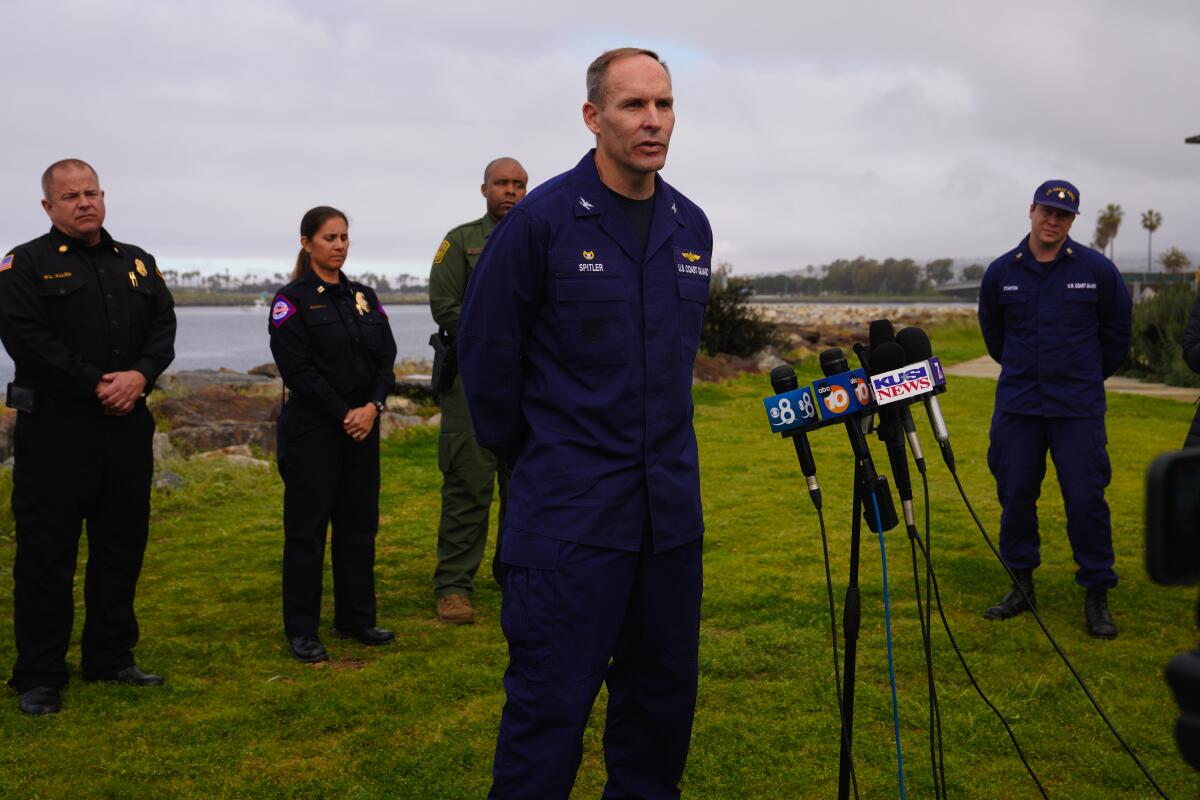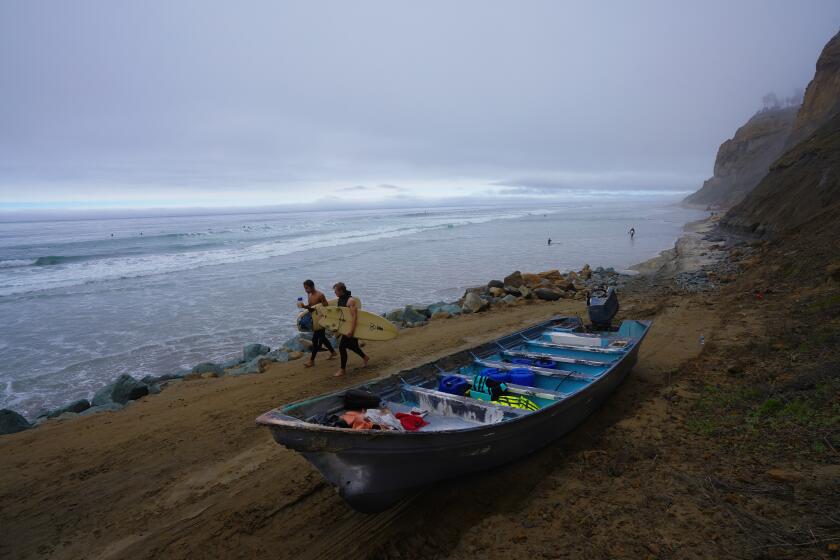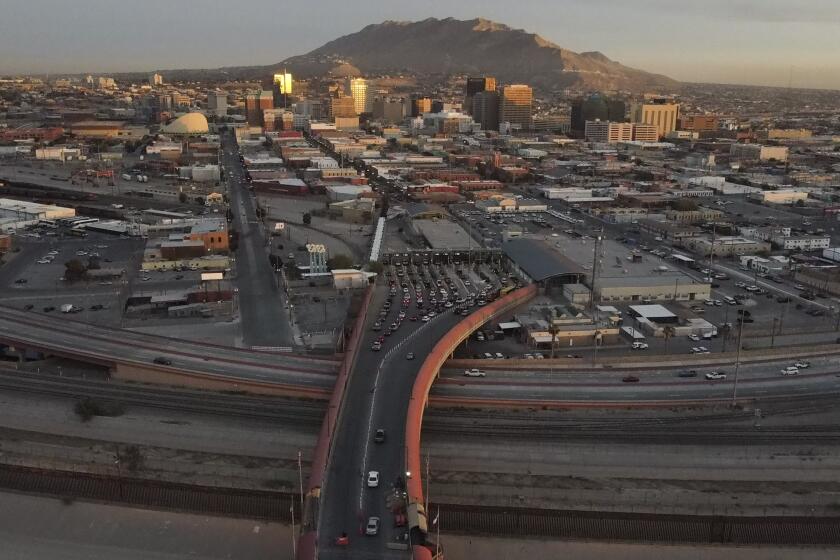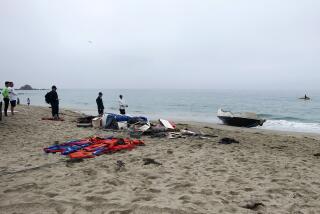Smuggling boat tragedy off San Diego is latest in deadly surge of ocean border crossings

- Share via
SAN DIEGO — Just after midnight one Friday in late October 2021, the captain of a fishing boat sailing nearly 100 miles off the San Diego coastline saw a faint light in the distance. In what a Coast Guard pilot later described as a miracle, the captain had spotted the occupants of a disabled, overloaded fishing boat signaling for help.
The 25 migrants on board had been stranded at sea for three days in a boat meant to hold just a few people. All things considered, they were lucky — they had survived.
As maritime smuggling attempts along Southern California’s coastline have surged in recent years, so too have mishaps and deaths. Authorities and experts say a number of forces have influenced both the rise in such incidents and the attention they have received.
Saturday night offered the latest and most lethal example of the dangers of such crossings, when at least eight people died after two suspected smuggling vessels capsized near Black’s Beach in San Diego.
“This all points to how dangerous border crossings have become, especially maritime crossings,” said Pedro Rios, a human rights advocate and the director of the American Friends Service Committee’s U.S. Mexico/Border Program.
The 911 caller who alerted authorities to the incident said between 16 and 23 people were on board the two vessels. Authorities didn’t find any survivors, though it was not yet clear Sunday if there were additional victims, or if the survivors fled before emergency crews arrived on the beach.
Officials said one of the boats reportedly capsized off Black’s Beach, south of the Torrey Pines Gliderport, shortly before midnight.
Either way, officials called it one of the deadliest maritime incidents in San Diego history, if not the deadliest, and said it highlighted the dangers of such border-crossing attempts.
“Every time they get into a panga to come northbound, their lives are at risk,” Capt. James Spitler, commander of the Coast Guard’s San Diego sector, told reporters Sunday morning. At least 23 people have died since 2017 in maritime crossings, he said, but added that “the real number of deaths in the California coastal region is unknown. Often these boats are overloaded [and] the maintenance is poor.”
At least three migrants died last year off the San Diego County coast. A man and woman drowned in November when their panga overturned off Imperial Beach, and a man died and three others were injured in April when their panga overturned near Ocean Beach.
In 2021, at least four people died, all in May. Early in the month, a boat carrying at least 32 migrants crashed and broke up on a Point Loma reef. Three people died and the others suffered injuries. Later that month, one person died and at least eight others were hospitalized when a panga capsized off La Jolla.
A year prior, at least four people died in ocean crossing attempts. Two died in February when their vessel overturned off the coast of Imperial Beach, and two others died in August off Ocean Beach.
Federal authorities have rescued, or intercepted and detained, hundreds of others during that span.
U.S. Customs and Border Protection says a large number of migrants in Mexico who tried to push their way into the United States were blocked.
Smugglers turning to the Pacific Ocean is not new — two people died in January 2010 off Torrey Pines State Beach — but the attempts have risen significantly.
Southern California’s coastal region has seen a 771% spike in maritime human smuggling incidents since 2017, Spitler said Sunday.
So far this fiscal year, which started last October, Border Patrol has recorded some 300 maritime crossings involving swimmers, surfboards, pangas and other types of vessels, according to Eric Lavergne, special operations supervisor for the Border Patrol’s San Diego sector.
Arrests at sea during smuggling attempts increased more than 90% in 2020 from the year before, jumping from 662 to 1,273, according to U.S. Customs and Border Protection.
A federal judge has ordered authorities to end the expedited releases of migrants entering from Mexico, potentially straining already stretched holding facilities.
Spitler, the Coast Guard commander, contended that not all those crossing the border by sea are migrants seeking a better life.
“This is part of a transnational criminal organization effort,” he told reporters Sunday at a news conference outside San Diego lifeguard headquarters. “These people are often labor trafficked and sex trafficked when they arrive.”
Federal officials have also warned in recent years that not all vessels launching from Mexico are landing close to the border, with some now bypassing San Diego County altogether.
Maritime smuggling has significantly increased in Orange, Los Angeles and Ventura counties, according to the Department of Homeland Security. In 2021, officials responded to a record number of 12 incidents in the areas of Long Beach, Malibu, Newport Beach, Palos Verdes and San Pedro. The first-ever panga landing on Santa Catalina Island also was reported that year.
Saturday’s deaths were the latest in a string of large-scale smuggling tragedies in Southern California. In March 2021, two months before the boat crash that left three victims dead, 13 migrants died and 12 others were injured when their SUV collided with a big rig in Imperial County.
The Biden administration is considering detaining migrant families who cross into the U.S. illegally as it prepares to end COVID-19 restrictions at the U.S.-Mexico border.
Rios, the human rights activist, said dangerous crossings are the result of U.S. policies.
“A lot of these individuals possibly might have wanted to present themselves at ports of entry, maybe for asylum claims,” he said. U.S. enforcement efforts and policies have “pushed people to have to take much more dangerous and extreme measures.”
Title 42, the pandemic-era policy that expels asylum seekers and other migrants caught crossing the border without documents, is among those measures, Rios said.
Border Patrol officials have also said that criminal groups have attempted to circumvent tighter border security by taking to the sea.
More to Read
Sign up for Essential California
The most important California stories and recommendations in your inbox every morning.
You may occasionally receive promotional content from the Los Angeles Times.
















